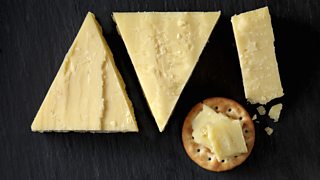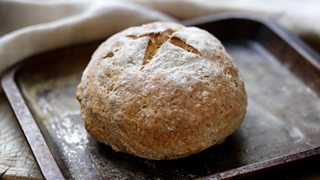Ed Gamble’s guide to the perfect cheeseboard
In ����ý Radio 4 podcast One Dish, chef Andi Oliver talks to a famous guest about a food that holds meaning to them. They unpack its secrets, from the history behind how it came to exist, to what memories and associations make it so special. Plus, psychologist and nutritionist Kimberley Wilson pops in to give some scientific insight.
Andi meets her Great British Menu colleague and comedian Ed Gamble to talk about the magic of a well-curated cheese board.

“A never-ending smorgasbord of possibility”
“I’ve loved cheese my whole life,” says Ed. “My mum, when I was growing up, regularly used to find teeth marks in the cheddar. That’s how much I love cheese – I ate it like an apple.”
My mum, when I was growing up, regularly used to find teeth marks in the cheddar.Ed Gamble
With a cheeseboard, it’s the “variety of cheeses” that make it so special, he argues. Andi agrees: “It’s a never-ending smorgasbord of possibility.”
The main players
For Ed, there are specific varieties of cheese that need to be present for it to qualify as a proper cheeseboard. “I’m happy with any cheeseboard but you need the basic things accounted for,” he states.
Firstly, a hard British cheddar: “A lovely cheddar – strong, mature.” If it has those little salty crystals in it, all the better.
Secondly, “a soft cheese.” This could be a goat’s cheese, Ed suggests. But, “if you have a really good Brie or Camembert, then there’s probably no need for the goat. I can sub it out.”
Equally important is a blue cheese. “There has to be a blue,” says Ed. “If there’s not a blue, it’s not a cheeseboard.” He proposes a traditional Stilton like a Colston Bassett.
And finally, Comté. “Comté’s got to be in there,” states the comedian. Andi agrees that it is, quite frankly, “cheese of gods.”
Some might argue that two or three cheeses qualify as a cheeseboard. But Ed is adamant: there have to be four, minimum. “But then once you start getting past the four, I’ll take anything,” he admits. “I’ll take suggestions.”
The smellier the better
In Ed’s opinion, the smellier the cheese the better. “I like a bit of everything, but I will push it.” His reasoning? “If I’m sharing cheese with people, I like to take it to the edge so they don’t eat the worst of the smelliest stuff, so I can have it,” he says. “So Stinking Bishop, fantastic stuff.” And he has another recommendation: a pungent Scottish cheese called “Minger”. (Although it did make everything else in his fridge taste of Minger too.)

Cracking crackers
For Ed, crackers and oatcakes are simply “a vehicle for cheese”.
“Sometimes I won’t even have a cracker,” he admits. As a type 1 diabetic, “cheese is a wonderful thing,” he says. “Instead of a dessert, it’s good to just have a bit of cheese – fat and salt and lovely stuff like that – that doesn’t affect my blood glucose level.”
However, he’s a big fan of the Hovis biscuits that often feature in festive multipacks of crackers: “Mature cheddar on essentially a digestive biscuit”.
A sweet morsel or two
On most thoughtfully put together cheeseboards you’ll find a smattering of grapes or a sweet membrillo (traditional Spanish quince jelly). Ed, however, is strongly opposed. “I’m not a fan of any of the sweet fripperies that people put on there… I don’t need that on my cheese. I don’t need anything else to bring out the flavour of the cheese.”
But he will enjoy a pickle that’s sour as well as sweet, and nice and sticky, like a red onion chutney or a fig and balsamic relish.
“I also like cheese with a bit of peanut butter,” says Andi, rather surprisingly. “It’s really good.”
Why are sweet titbits with a savoury cheeseboard so satisfying?
Nutritionist Kimberley Wilson explains…

“The little bumps on your tongue, called papillae, each contain thousands of receptors for the basic tastes: bitter, sour, umami, salty and sweet. Fascinatingly, it was recently discovered that a type of receptor called the SGLT1 can be found on the tongue’s sweet sensing cells, but this receptor is only activated in the presence of salt. This could explain why the presence of salt enhances sweet flavours."
"We like salt, sugar and umami individually but when they are combined, we experience something called hedonic escalation. Essentially, the pleasure of the combined taste is greater than the sum of its parts. This could be an evolutionary adaptation to encourage us to eat a diverse range of foods, which is a good strategy to help us obtain a broad range of nutrients. But it does also mean that a well-stocked cheese board can be impossible to resist…”
The origins of the cheeseboard are French
“In the Middle Ages, British dining, for those who could afford it, was influenced by the French,” Andi explains. “Meals would be around three courses, but each course would include up to a dozen dishes, almost like a buffet on the table in front of you. This was known as service à la française. The third course was a dessert course which included candied and fresh fruit, and cheese.”
“However, in the Victorian era this was replaced with service à la Russe (influenced by the Russian tsar’s court), which was made up of courses of one dish, already plated up.” What began as up to a dozen courses dwindled to five over time. “The dessert course was split into savoury and sweet courses with the savoury course being things like devilled kidneys, Welsh rarebit – or cheese and biscuits.”
Cheddar accounts for around half of British cheese sales
Cheese has been produced in Britain since the Middle Ages, but something happened in the 1840s to transform the British cheese industry. Somerset cheesemaker James Harding found an easier, more efficient way to drain curds of their moisture. The local cheese, cheddar, had previously been expensive to produce and this innovation dramatically reduced costs.
“It was so successful that cheddar became the most popular cheese in Britain and even other British cheeses that had originally been soft, like Cheshire or Wensleydale, were adapted to become hard cheeses using this method,” explains Andi. To this day, cheddar remains the most popular cheese in the UK and accounts for around half of all cheese sales.
Listen to One Dish on ����ý Sounds
More from ����ý Radio 4
-
![]()
The surprising history of soda bread
The science, story and memory behind the humble loaf.
-
![]()
The secret power of plantain
Discover the magical qualities of this special food.
-
![]()
The Food Programme: The Future of Cheese
Dan Saladino finds out what the future holds for cheese, including the role of raw milk.
-
![]()
A Thorough Examination with Drs Chris and Xand
Chris van Tulleken is on a mission to get his twin Xand to quit ultra-processed food.





